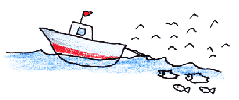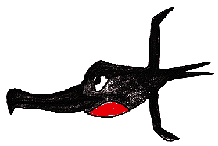The Japan Environment Agency, in an effort to protect wildlife in danger of extinction, has founded a number of wildlife protection centers in important regions with rare wild plant and animal life to protect these species, promote their spread and growth through breeding and propagation projects, and to carry out research and investigation. The Hokkaido Seabird Center is one such wildlife center, focusing on bird species, many of which, such as the common murre and the tufted puffin, are on the brink of extinction . Other wildlife protection centers include:

- Hokkaido – Kushiro City (fish owl)
- Niigata Prefecture – Shinbo Village (Japanese ibis)
- Okinawa Prefecture – Taketomi Town (Iriomote wildcat)
- Kagoshima Prefecture – Yakushima Island (Yakushima rare and indigenous plant species)
- Nagasaki Prefecture – Tsushima Island (Tsushima wildcat)
-
-

Teuri Island, located in the Sea of Japan off the coast of Haboro Town in Hokkaido, is one of the world’s most prominent seabird breeding grounds. Visitors to the center can learn about eight species (Japanese cormorant, Pelagic cormorant, slaty-backed gull, black-tailed gull, common murre, spectacled guillemot, rhinocerous auklet, and ancient murrelet) living on Teuri as they explore a large scale model of a breeding environment, featuring lights, sound, and special effects, as well as bird carvings by Sapporo artist Kumiko Kitao. Also See: Teuri Island, Yagishiri Island in Haboro -

For each of the species featured in the large scale model, there are also model eggs on exhibit. The model eggs approximate the actual size, quantity and weight of real eggs and are displayed in a manner to accurately reflect each species’ breeding habits. The eggs of the ancient murrelet, for example, are very large in proportion to its body size, so only one or two can be laid each year, where the cormorant, on the other hand, lays a large number of tiny eggs each year. -
In order to show why Teuri Island is such a prominent sea bird breeding ground, a three dimensional relief model of the island is embedded in the floor. The west coast of Teuri is characterized by steep cliffs and jagged rocks, terrain which has attracted large numbers of seabirds to nest on the island. The east coast, on the other hand, is smooth and flat, supporting human settlement. These topographical featurs have made it possible for human and seabird to coexist on the same island.
-
The great auk was the largest bird in the alcid family until it was hunted to extinction over 150 years ago. But thanks to Japan’s leading bird sculptor, Haruo Uchiyama, visitors can see and touch a life sized model while learning about its history.
-

A panel display by Haruo Uchiyama about the category I-A common murre and the category II spectacled guillemot, both nearing extinction in Japan, as well as the common rhinocerous auklet. The display presents information about their worldwide distributions, their situations in Japan, and the individual numbers on Teuri Island. -

“Teuri Island Seabirds” in Japanese (CD on loan from Nature Live) “The State of Seabird Protection in Japan” in Japanese (CD on loan from Nature Live) “Japanese Birds” in Japanese and English (Promotional CD) Five Macintosh computers available for CD-ROM viewing. -
Teuri Island in Hokkaido is a place where humans and seabirds coexist. Rhinoceros auklet and black-tailed gull breeding ecology comes into contact with the lifestyle of human beings on this island.
-
-
-
A frequently updated permanent display of information about nature in Haboro, covering not just seabirds, but also flowers, insects, and other nature topics.
-
A display of artwork made from various debris that has drifted ashore from the sea. Also on display is “Recollections of the Sea,” stories written by participants in a center sponsored ocean observation program.
-
The wandering albatross, with a wingspan of as much as 3.5m, is the world’s largest seabird. This bulletin board displays information about the bird, including instructions on making a life-sized model out of old newspapers.
-
A continually updated bulletin board of newspaper clippings about nature related news and events all over the prefecture.
-
A collection of illustrated leaflets visitors can take home with them. They introduce nature developments and changes in Haboro and are updated every ten days. There is also an extended display with more detailed information that visitors can review. Additionally, beginning in September, we will offer guided tours of the exhibits in the building.
-
Japanese Seabirds List
The following is a list of all seabird species observed in Japan. From the Japan Bird Species Catalog, Rev. 5 (1974) by the Japan Ornithological Society. Numerous species only confirmed in the years since the publication of this catalog are not included in this list.
- Family Spheniscidae (0)
- No penguins

- Family Diomedeidae (3)
- Short-tailed Albatross
- Laysan Albatross
- Black-footed Albatross

- Family Procellariidae (13)
- Fulmar
- Solander’s Petrel
- White-necked Petrel
- Bonin Petrel
- Stejneger’s Petrel
- Bulwer’s Petrel
- Streaked Shearwater
- Wedge-tailed Shearwater
- Pale-footed Shearwater
- Sooty Shearwater
- Slender-billed Shearwater
- Christmas Shearwater
- Audubon’s Shearwater

- Family Hydrobatidae (7)
- Wilson’s Storm Petrel
- Grey Fork-tailed Petrel
- Leach’s Fork-tailed Petrel
- Swinhoe’s Fork-tailed Petrel
- Madeiran Fork-tailed Petrel
- Tristram’s Fork-tailed Petrel
- Matsudaira’s Fork-tailed Petrel
- Family Pelecanoididae (0)
- No diving-petrel

- Family Phaethontidae (2)
- Red-tailed Tropic bird
- White-tailed Tropic bird

- Family Pelecanidae (1)
- Spotted-billed Pelican

- Family Sulidae (3)
- Brown Booby
- Blue-faced Booby
- Red-footed Booby
- Family Phalacrocoracidae (4)
- Common Cormorant
- Temminck’s Cormorant
- Pelagic Cormorant
- Red-faced Cormorant

- Family Fregatidae (2)
- Pacific Frigate Bird
- Lesser Frigate Bird

- Family Sterorariidae (4)
- Great Skua
- Pomarine Jaeger
- Parasitic Jaeger
- Long-tailed Jaeger

- Family Laridae (31)
- Black-headed Gull
- Herring Gull
- Slaty-backed Gull

- Glaucous-winged Gull
- Glaucous Gull
- Common Gull
- Black-tailed Gull
- Saunder’s Gull
- Sabine’s Gull
- Black-legged Kittiwake
- Red-legged Kittiwake
- Ross’s Gull
- Ivory Gull
- White-winged Black Tern
- Whiskered Tern
- Black Tern
- Caspian Tern
- Greater Crested Tern
- Gull-billed Tern

- Common Tern
- Roseate Tern
- Black-naped Tern
- Aleutian Tern
- Spectacled tern
- Bridled Tern
- Sooty Tern
- Little Tern
- Blue Noddy
- Brown Noddy
- Black Noddy
- White Noddy
- Family Rynchopidae (0)
- No Skimmers

- Family Alcidae (14)
- Common Murre
- Thick-billed Murre
- Pigeon Guillemot
- Spectacled Guillemot
- Long-billed Murrelet
- Ancient Murrelet
- Japanese Murrelet
- Crested Auklet
- Whiskered Auklet
- Least Auklet
- Parakeet Auklet
- Rhinoceros Auklet
- Horned Puffin
- Tufted Puffin
Address and Contact:
Hokkaido Seabird Center 1 Kita 6-jo 1-chome, Haboro Town (Haboro-cho), Tomamae-gun (Tomamae District), Hokkaido 078-4116, JAPAN Tel: ++81 (0) 164-69-2080 Fax: ++81 (0) 164-69-2090
Office of the Ministry of Environment & Nature Conservation, Haboro (inside Hokkaido Seabird Center)
Tel: 0164-69-1101 Fax: 0164-69-1102
Hokkaido Seabird Center Website: http://www.seabird-center.jp/ (Japanese Only)
Haboro ↔ Teuri Island/Yagishiri Island by Haboro Coast Ferry
